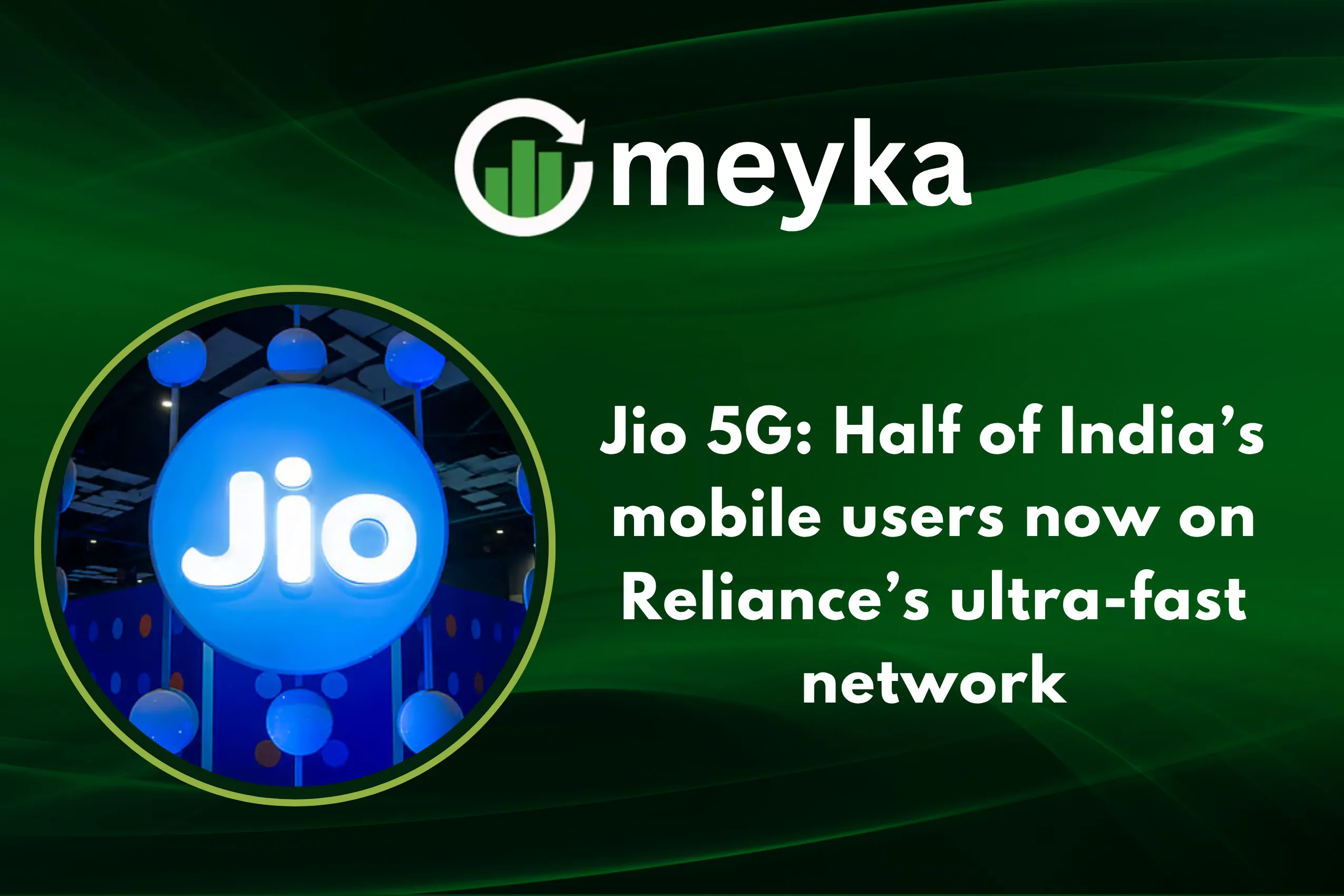Jio 5G: Half of India’s mobile users now on Reliance’s ultra-fast network
We are in the midst of a big shift in mobile connectivity in India. Jio’s ultra-fast 5G network is now used by nearly half of its mobile subscribers, around 234 million users at the end of September 2025.
What does this mean for us? It means faster downloads, smoother streaming, and the promise of richer digital services reaching more people, even in places that lagged behind. We’ll explore how Jio achieved this milestone, why it matters for India’s telecom and digital future, what challenges remain, and how things may play out next.
Background: The Indian mobile-telecom context
India ranks among the nations with the highest number of mobile subscribers worldwide. As of August 2025, total mobile subscriptions in India had reached about 1,167 million (1.167 billion). The jump from 4G to 5G is not just about speed, it’s about enabling new services, higher data usage, and digital inclusion. To roll out 5G, Indian telecom companies and the government together had to invest in spectrum auctions, infrastructure, and digital ecosystems.
In this landscape, Jio has emerged as a major player. Its parent, Reliance Industries (through its telecom arm), launched 5G services and aggressively built out its network. Given the competition from other providers like Bharti Airtel and Vodafone Idea, the stakes are high.
Jio’s 5G rollout & scale-up
Jio launched its 5G services across major Indian cities in late 2022, and then expanded rapidly.
By June 2025, Jio reported around 213 million 5G subscribers, a year-on-year increase of roughly 64% from about 130 million in the previous year. Then by September 2025, that number jumped to 234 million, which Jio says accounts for nearly 50% of its mobile subscriber base.
Beyond subscriber count, 5G traffic is also climbing rapidly, Jio says that roughly half of its wireless network traffic now runs on 5G. These numbers underline how fast the shift is occurring in the Indian telecom market.
What has enabled Jio’s 5G dominance
Several key factors have helped Jio become a frontrunner in 5G:
Infrastructure and technology
Jio has deployed its own mid-band 5G cells and worked on “True 5G” coverage across Indian districts. The company also started manufacturing its own small cells and radio equipment (in partnership with Sanmina near Chennai). This reduces dependency on foreign suppliers and may cut costs.
Affordable plans and wide reach
Jio’s pricing strategy and wide network reach help it tap mass-market users. For example, low-priced upgrade vouchers and affordable 5G data plans have been offered to draw in users.
Also, the 5G rollout has reached districts and semi-urban/rural areas, helping extend services to users beyond big metro cities.
Ecosystem and services
Jio bundles digital content, streaming apps, and fixed wireless access (FWA) broadband services. Its fixed wireless service, famous as Jio AirFiber, has captured large share of market in some regions. Together, these factors help Jio convert rollout into real usage and uptake.
Implications of Jio’s 5G leadership
What does Jio’s strong 5G position mean for users, the industry, and India’s economy?
For consumers
We get improved connectivity: faster downloads, high-definition video streaming, smoother gaming, better video calls. Even in places that lacked fiber infrastructure, 5G FWA can bring high-speed broadband.
That means more access to online education, digital health services, remote work and entertainment.
For the telecom industry
Jio’s rapid move puts pressure on competitors to accelerate their 5G rollout and improve service quality. It also raises questions about monetising 5G: having many users is good, but earning substantial revenue from each user (ARPU) is key.
Jio’s reported ARPU (average revenue per user) has recently risen (to about ₹211) which shows progress.
For India’s economy & digital ambition
A strong 5G network supports new digital services: Internet of Things (IoT), smart cities, virtual reality, cloud gaming, and Automation in enterprises. A report says mobile data consumption in India is expected to grow from about ₹726 billion in 2024 to over ₹2.21 trillion by 2030, driven by 5G and digital usage.
Therefore, Jio’s lead in 5G can contribute significantly to India’s digital transformation, bridging the urban-rural divide.
Challenges & caveats
While the 5G story for Jio looks strong, there are several caveats and hurdles we must keep in mind.
Definition- and metrics-based issues
Saying “half of mobile users are on 5G” requires clarity: are we talking active users, connected users, or device-capable users? Some claims use “subscriber” loosely. While Jio reports 234 million 5G subs, we must verify how many are actively using 5G.
Monetisation and ARPU pressure
Earning from users is harder than acquiring them. Lower-priced 5G plans may attract numbers, but may not raise revenues proportionally.
Infrastructure and coverage gaps
Despite rapid rollout, ensuring consistent 5G coverage in remote, rural or interior areas remains challenging. Power, backhaul connectivity, spectrum and site permissions remain issues.
Competition and regulation risks
Other telecom players, changing government policy, spectrum cost hikes and regulatory shifts may impact margins and growth.
Technology evolution risk
5G is not the final frontier, 6G and other wireless technologies loom. Keeping up will require constant investment.
Also, reports emerged of service issues: for example a July 2025 outage where many Jio users found themselves locked to 4G data despite subscribing to 5G plans.
What’s next for Jio and India’s 5G journey
So, where do we go from here?
Jio’s future plans
Jio is working to expand its fixed wireless access (FWA) business, enterprise 5G services, and global deployment of its in-house 5G stack. As reported, Jio recently said 5G now accounts for half its wireless traffic, indicating usage is growing not just subscriptions.
Industry outlook
With one study projecting India’s mobile data consumption growing at 22 % CAGR from 2025-30, and 5G being a key driver, the stage is set for the next phase of digital growth.
Digital economy & inclusion
We should expect broader use of 5G in sectors like education, healthcare, agriculture, remote work. Jio’s reach into rural and semi-urban areas may help bridge digital divides.
For users like us
We may see affordable 5G-capable handsets, more service bundles (internet + content + apps), and perhaps growth in new services like cloud gaming and augmented reality.
Risks and watching-points
We should keep an eye on service quality (are we really getting 5G speed and coverage?), pricing stability (will plans stay affordable?), and value delivered (are new apps/services showing up?).
Conclusion
In summary, we can say that Jio’s 5G rollout has achieved a remarkable milestone, with roughly half of its mobile users now on 5G (and perhaps half its traffic on 5G) it has set a strong benchmark in India’s telecom market. This isn’t just about faster download speeds, it’s about opening a gateway to a digital-first future for millions of Indians.
Yet, the real test lies ahead: delivering on the promise of new services, maintaining quality, monetising sustainably, and ensuring everyone benefits, urban and rural alike. As users, we stand to gain, but we’ll also expect value, reliability and innovation.
The next chapter in India’s connectivity journey has begun, and Jio’s 5G leadership is a major part of the story.
FAQS:
Reliance Jio had about 213 million 5G users by June 2025.
OnePlus and Jio ran a demo using the OnePlus Nord 4 smartphone. They created separate virtual network slices for different apps to show how 5G data can be tailored by use-case.
Not exactly. Jio offers “unlimited” 5G data on certain eligible recharge plans, but you must meet plan criteria and have a 5G-capable phone and network coverage.
Disclaimer:
This content is for informational purposes only and is not financial advice. Always conduct your research.






